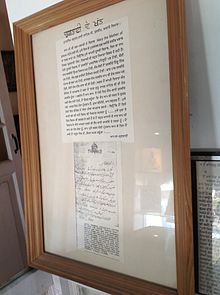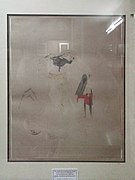| Abdur Rahman Chughtai عبد الرحمن چغتائیPP HI | |
|---|---|
 | |
| Born | (1897-09-21)21 September 1897 Lahore, Punjab, British India |
| Died | 17 January 1975(1975-01-17) (aged 80) Lahore, Punjab, Pakistan |
| Nationality | Pakistani |
| Movement | Chughtai style of painting |
| Awards | |
| Website | chughtaimuseum |
Abdur Rahman Chughtai (21 September 1894 – 17 January 1975) was a painter, artist, and intellectual from Pakistan, who created his own unique, distinctive painting style influenced by Mughal art, miniature painting, Art Nouveau and Islamic art traditions. He is considered to be 'the first significant modern Muslim artist from Pakistan', and the national artist of Pakistan.
He was given the title of Khan Bahadur by the British Empire in British India in 1934, awarded Pakistan's Hilal-i-Imtiaz (Crescent of Excellence) Award in 1960, and the Pride of Performance Award in 1958 by the President of Pakistan.
Early life and career
Chughtai was born on 21 September 1897 in Lahore, now in Pakistan. He was the second son of Karim Bukhsh, who belonged to a prominent Punjabi Muslim family of artists descending from generations of craftsmen, architects, and decorators. Chughtai briefly learned naqqashi from his uncle Baba Miran Shah Naqqash at a local mosque. After completing his education at the Railway Technical School, Lahore, in 1911, Chughtai joined the Mayo School of Arts, Lahore (now called National College of Arts, Lahore), where Samarendranath Gupta, a pupil of Abanindranath Tagore was Vice-Principal. After leaving the school, he made a living for a while as a photographer and drawing teacher. He eventually became the head instructor in chromo-lithography at the Mayo School.

In 1916, Chughtai's first painting in a revivalist 'oriental' style appeared in the Modern Review magazine. He had his first exhibition in 1920 at the Punjab Fine Art Society. He also exhibited with the Indian School of Oriental Art during the 1920s, by which time he had become quite renowned. His work contributed greatly to Lahore's burgeoning modern art scene. While he predominantly worked with watercolors, Chughtai was also a print-maker, perfecting his etching skills in London during visits in the mid-1930s. His sketches were used in many books in Punjabi poetry by Bhai Vir Singh for illustrating his famous poems like "Kambadi Kalai" and including his famous epic "Rana Surat Singh". Chughtai offered his gratitude to Bhai Vir Singh for becoming part of these illustrations as a young artist in his letter to him on 11.04.1929
In his sixty years of artistic creation, Chughtai produced nearly 2000 watercolours, thousands of pencil sketches, and nearly 300 etchings and aquatints. He also wrote short stories, and articles on art. He designed stamps, coins, insignia and book covers. He was also an avid collector of miniatures and other art. He published three books of his own work: the Muraqqai-i-Chughtai (1927), Naqsh-i-Chughtai (c. 1935) and CFqueenhughtai's Paintings (1940). The Muraqqa-i-Chughtai was a sumptuously illustrated edition of Mirza Ghalib's Urdu poetry, with a foreword by Sir Muhammad Iqbal. It is regarded as the most significant work of Chughtai's career and in its time, was considered the finest achievement in book production in the country.
After the creation of Pakistan in 1947, Chughtai came to be regarded as one of the most famous representatives of Pakistan. Chughtai's paintings were given to visiting heads of state Allama Iqbal, Pablo Picasso, Elizabeth II was amongst his admirers.
Chughtai's closest associate was his younger brother Abdullah Chughtai, a scholar and researcher of Islamic art. Chughtai married twice, and had two children, a son and daughter. He died in Lahore on 17 January 1975.
Art

Chughtai's early watercolours take off from the revivalism of the Bengal School of Art – his Jahanara and the Taj, for instance, shows the influence of Abanindranath's The Last Moments of Shah Jahan. By the 1940s, he had created his own style, strongly influenced by Islamic art traditions, but retaining a feel of Art Nouveau. His subject matter was drawn from the legends, folklore and history of the Indo-Islamic world, as well as Punjab, Persia and the world of the Mughals.
Abdur Rahman Chughtai also designed the logo for the Pakistan Television Corporation (PTV) at the behest of its first general manager, Ubaidur Rahman. The logo has been tweaked and modified over the years since its inception but remains fundamentally the same. On Pakistan's independence day in 1951, he produced a set of 9 stamps, better known as 'Chughtai Art set'. At that time, this set was considered as the most beautiful stamps of the world.
Artist and gallery owner Salima Hashmi deems Chughtai one of South Asia's foremost painters. "He was part of the movement that started in the early part of the 20th century to establish an identity indigenous to the subcontinent", she said. "He rejected the hegemony of the British Colonial aesthetic".
Painting exhibits
Chughtai's works are owned by the British Museum, the Victoria and Albert Museum, the National Gallery of Modern Art (New Delhi), the Peace Palace (in The Hague), United Nations Headquarters, New York, the Kennedy Memorial in Boston, the US State Department (in Washington, D.C.), President's House Bonn, AP State Archaeology Museum,
Queen Juliana's Palace in the Netherlands, Emperor's Palace Bangkok, President House Islamabad, Governors' Houses in Lahore and Karachi, and the National Art Gallery, Islamabad. Many of his works are at the Chughtai Museum Trust in Lahore, Pakistan.
Works
- Maqalat-i Chughtaʾi. 2 vols. Islamabad: Idarah-yi Saqafat-i Pakistan, 1987.
- Lahaur ka dabistan-i musavviri. Lahore: Chughtai Museum Trust, 1979.
- Chughtai’s Paintings. 2nd ed. Lahore: Print Printo Press, 1970.
- Amal-i Chughtaʾi: Poet of the East Lahore: Self-published, 1968.
- Naqsh-i Chughtaʾi: Divan-i Ghalib Musavvir. Lahore: Ahsan Bradarz, 1962.
- Chughtai’s Indian Paintings. New Delhi: Dhoomi Mal, 1951.
- Muraqqaʿ-i Chughtaʾi. Lahore: Jahangir Book Club, 1927.
Other works
Among Chughtai's popularly known works are Hashim Shahbaz and Radio Pakistan and his painting of Anarkali for the cover of a 1992 drama. Additionally, one of the most successful UNICEF cards features a Chughtai piece. He was also known for his designs of postage stamps. United Nations Organization art correspondent Jacob-Baal Teshuva wrote that Chughtai's paintings are the largest set released in 1948.
Awards and recognition
- Awarded the title of 'Khan Bahadur' in 1934 by the British Empire
- Hilal-i-Imtiaz (Crescent of Excellence) Award in 1960 by the President of Pakistan
- Pride of Performance Award in 1958 by the President of Pakistan
Gallery
See also
References
- ^ "Profile of Abdur Rahman Chughtai - Pakistani Artist". Encyclopædia Britannica. Retrieved 20 June 2019.
- ^ Iftikhar Dadi (2010). Modernism and the art of Muslim South Asia. University of North Carolina Press. ISBN 978-0-8078-3358-2.
- ^ Profile of Abdur Rahman Chughtai on Grosvenor Gallery website Retrieved 20 June 2019
- ^ "Profile at Chughtai Museum website". Chughtai Museum. Archived from the original on 30 December 2010. Retrieved 20 June 2019.
- Srivastava, R. P. (1983). Punjab Painting. Abhinav Publications. ISBN 978-81-7017-174-4.
His ancestors were Lahori (Punjabi)...
- ^ Abdul Rahman Chughtai - Traditional Painter from Pakistan Caroun.com website, Retrieved 20 June 2019
- ^ Partha Mitter (1994). Art and Nationalism in Colonial India, 1850–1922: Occidental Orientations. Cambridge University Press. p. 332. ISBN 978-0-521-44354-8.
- ^ Profile of Abdur Rahman Chughtai on artocraft.com website Retrieved 20 June 2019
- "Profile of Abdur Rahman Chughtai, 1897–1975". Charles Moore Fine Arts. 16 December 2011. Retrieved 20 June 2019.
- Abdul Rehman Chugtai's letter dated 11/04/1929 Lahore preserved in Bhai Vir Singh Memorial House, Amritsar
- Jonathan M. Bloom; Sheila Blair (2009). The Grove Encyclopedia of Islamic Art and Architecture. Oxford University Press. p. 489. ISBN 978-0-19-530991-1.
- G. Venkatachalam (1948). Contemporary Indian Painters.
- "Andhra Pradesh State Archaeology Museum". Archived from the original on 15 February 2012. Retrieved 20 June 2019.
- NCA and Stamp Design, National College of Arts, Lahore, Pakistan, 2000 p. 5
- Stanley Gibbons Stamp Catalogue Bangladesh, Pakistan and Sri Lanka, Stanley Gibbons Limited, London, UK 2005 1st edition p. 18







